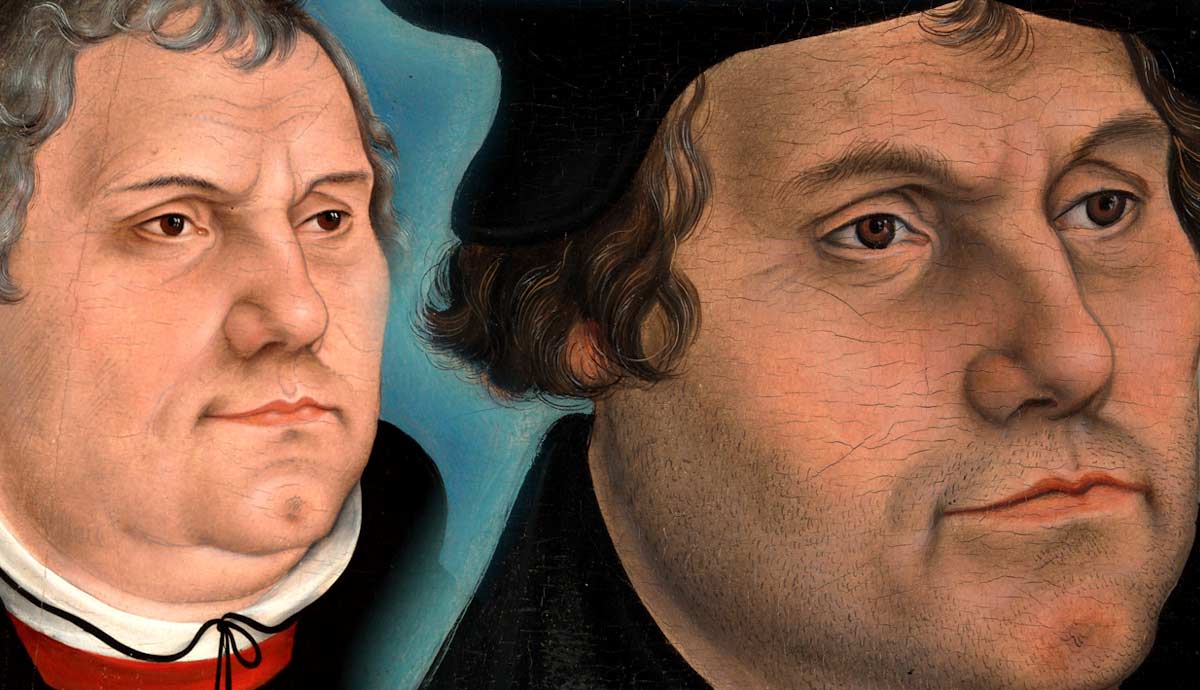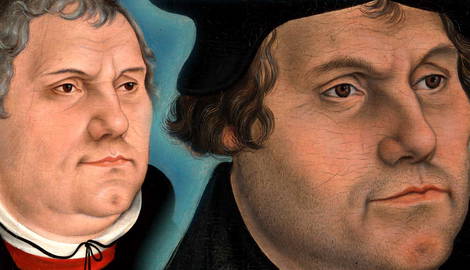
Art has always played an important role in movements that sweep across nations. One of the most significant movements was the Protestant Reformation in 1517. The Protestant Reformation began when a German priest named Martin Luther nailed 95 complaints against the Catholic Church to the door of a church in Wittenberg, Germany. Once the grievances had aired, it ignited a spark that spread across the continent, but Luther could not hope to bring reform to Europe alone. His connections to a prominent artist, Lucas Cranach the Elder, helped create influence through art.
What Happened Before Lucas Cranach the Elder Started Making Art?

Martin Luther did not intend to start such a massive upheaval across Western Europe when he nailed his 95 theses to the church’s door in Wittenberg. He only wished to express his grievances, hoping they would lead to progressive reform in the Catholic Church. One of the most notable grievances he had with the Catholic Church was the sale of indulgences.
The people of Medieval Europe lived their lives around the rituals of the church, and they believed that after death, the soul would go to purgatory to be purged of its last remnants of sin before going to their final destination of the Kingdom of Heaven. The stay in purgatory could be of a different length for every soul, depending on how well they lived. However, everyone was expected to spend some time in purgatory because of the idea of original sin. They believed, however, that it was possible to shorten a soul’s time in purgatory so that they might reach Heaven quicker by purchasing an indulgence from the Catholic Church. Time in purgatory could also be shortened by serving penance, such as fasting on only bread and water or pilgrimaging to a holy site.
However, penance was often very inconvenient to busy, ordinary people. Therefore, buying indulgences to reduce their time in purgatory was easier for them. The Catholic Church, Luther observed, was more than happy to accept the payments with which they lined their coffers. As the centuries went on, the indulgences were broadened to include not only shortened time in purgatory for the buyer’s soul but also the souls of those already in purgatory. This caused families to buy indulgences for lost loved ones. By the 14th century, the money they acquired from selling indulgences was being used to build new churches in Rome.
Martin Luther and Humanism

Luther had studied and taught at the University of Wittenberg. He earned his doctorate in 1512 and supported humanist teachings that he had learned during his time at the university. Humanism was a philosophical stance devoted to the importance of the human experience. Humanism originated in Ancient Greece and was a significant part of the revival of classicism in the Renaissance. It marked a transition between the Medieval focus on the afterlife and the modern focus on life on Earth. Though the population in Europe was still vehemently religious, humanism created progress in more earthly matters, such as art, philosophy, medicine, and astronomy. It sought rationality in approaches to the human experience and was a defining aspect of the Renaissance.
Humanism was not always in accordance with the Catholic tradition, which made it unpopular with the Catholic Church. This did not stop it from infiltrating the minds of those in association with the Catholic faith. Martin Luther himself was a priest and had been influenced by the spreading ideas of humanism. Although many humanists remained Catholic all of their lives, such as the famous Erasmus of Rotterdam, they usually at least sought reform from within the Catholic Church according to their humanist values. Therefore, when the priest Martin Luther nailed the 95 theses to the door of the church in Wittenberg and published three pamphlets detailing the corruption of the Catholic Church, the Catholic Church responded by sending officials to debate him.
Who Supported Martin Luther?

Cardinal Cajetan and Johannes Eck were sent to disprove Luthers’ claims in public debates so that people would not be swayed away from the Church. Luther proved to have a talent for debate and refused to back down. The Catholic Church could see that they were losing public opinion in the area and took drastic action to cut the movement short. In June of 1520, a bull of excommunication was issued to Luther. The bull condemned Luther’s writings, accusing him of being a heretic and calling for the burning of his works. He became an outlaw and went into hiding.
Luther was lucky to have the support of Frederick III, Elector of Saxony. The Holy Roman Emperor was in a political situation with Italy that required the support of his German territories. Frederick III assisted Martin Luther by providing him a place to hide from Church authorities Eisenach. He also experienced support from the local population in Wittenberg.
With Luther far away in hiding, the Catholic Church likely hoped he would be forgotten. However, he had caused such a stir and rallied enough support that others kept the movement going despite its founder’s absence and criminal status. On Christmas Day in Wittenberg, Andreas Karlstadt, a friend of Luther’s, gave mass in the vernacular German language and gave communion to people who had not received confession. Another friend, a prominent artist named Lucas Cranach the Elder, created an illustrated publication for circulation. It was titled The Passion of Christ and the Antichrist, which highlighted the moral disparities between Jesus Christ of the Bible and the Pope.
Vows of Celibacy

Now an outlaw with a strong spirit of determination and supporters standing behind him, Luther threw all his effort and energy into the Reformation. He declared that salvation could be achieved through faith alone and notably discarded his vow of celibacy. He had written about marriage before, describing it as inherently holy. He claimed that the vows of celibacy that priests were forced to take in order to be a member of the Catholic church were not only unnecessary but encouraged improper behavior by creating a stigma. Everyone knew that priests often had mistresses and sometimes even families with their mistresses. He proposed to do away with their vows of celibacy and to allow the priests to take wives so that they would not be tempted to stray from the path that was set before them.
Despite his support of priests marrying, Luther himself claimed he never would. This changed in 1523 when nine nuns asked for his help in escaping their vows and finding suitable marriages. By 1525, all of these nuns had been married except for Katharina von Bora. Luther decided to take her for a wife, and they were married. Luther likely married Katharina because he felt he was responsible for finding her a husband. He would eventually develop a special fondness for her as a companion. Though the Reformation certainly caused him a tremendous amount of personal trouble, Luther was able to make many meaningful connections throughout.
Lucas Cranach the Elder’s Support

One of Luther’s most prominent supporters was the artist Lucas Cranach the Elder. Cranach was trained in the arts by his father, Hans Maler, and was highly inspired by one of his contemporaries, Albrecht Durer. By 1505, Cranach was a court artist to Frederick III, Elector of Saxony. The mutual acquaintance of the prince is likely what brought Luther and Cranach together. The result was a career filled with Protestant art and propaganda. Their close relationship and Cranach’s fervent support of Luther caused modern art historians to consider Cranach to be the leading artist of the Protestant Reformation.
Luther was named the godfather of Cranach’s daughter, and Cranach served as the witness for Katharina von Bora during her marriage to Luther. Cranach also regularly painted portraits for the Luther family, including a portrait of Luther’s daughter, Magdalena, who died when she was seven years old. Portraits of Luther are the most frequent, which would have been circulated as a form of propaganda to keep other Protestants informed. Cranach would work at the Saxon court for most of his life, creating artwork for Frederick III and his successors, Johann the Steadfast and Johann Freidrich the Magnanimous.
One of Cranach’s most important jobs was illustrating theological arguments for Luther’s teachings. The majority of the population was not literate, so to sway a large number of people from one side of an argument to another required them to understand what the argument was about. Since pamphlets could only reach those who knew how to read them, artwork was an essential tool for spreading stories from the Bible and information that would contradict the teachings of the Church compared with the direct content of the Bible.
Lucas Cranach the Elder’s Artworks as Propaganda

One of those crucial artworks was Law and Grace and Law and Gospel, which raises the question of how a soul can earn access to Heaven after death. This became a hotly debated topic in the 16th century, inducing mass violence and destruction across the continent as the differing opinions clashed. Cranach’s Law and Gospel sought to provide answers to the question of how one achieves entry into Heaven. The Catholic Church maintained that good deeds got believers into Heaven, including financial donations to the institution. Meanwhile, Protestants believed that a place in Heaven could be achieved through faith in God alone. As more people began to hear this new idea of religion, they became more aware of the corruption present in the Catholic Church.
Law and Gospel was painted in 1529. The work is divided into two scenes, split by a tall tree in the middle. On the left is the land of Law where death and a demon are leading a sinner into hell by poking him with a sharp spear. The man reacts with surprise and fear, raising his arms, while his mouth hangs open from a shriek. In the background, we see Adam and Eve just moments before they bite into the forbidden fruit. This scene serves as a reminder that law alone did not prevent them from biting into the apple, but a lack of faith in God.

The left side of the painting is meant to demonstrate that simply following the law is not a suitable path to Heaven and that the law cannot tell right from wrong. This is a jab at the Catholic Church, the historic overarching lawmakers of Europe in terms of religion. The painting tells viewers that just because a mortal man says they are God’s representative on Earth and that they make the rules for God in his stead does not mean they have good intentions, and that the only way to ensure a soul’s place in Heaven is through direct faith in God himself, cutting out the middle-man entirely.
The right side of the painting depicts the land of the gospel. On this side of the painting, viewers can see John the Baptist leading a naked man to Christ. Christ is depicted on the cross but also risen from the grave. Showing Christ as risen, standing triumphantly above the cave in which he was sealed, brings the miracle of the Resurrection to the viewers and promises the same to them through faith. The man who is being shown this miracle is not counting his good deeds as he approaches the divine figure but instead has submitted his soul to God’s mercy entirely through faith and therefore is awarded privileges that the damned soul on the left is not.
Martin Luther and Lucas Cranach the Elder brought change to Europe, sweeping the continent into religious and political turmoil. When Luther nailed the 95 theses to the door of the church in Wittenberg, he began a revolution of reform that would bring down the ire of the Catholic Church upon his head, spill the blood of countless lives, and alter the world’s social landscape forever.










